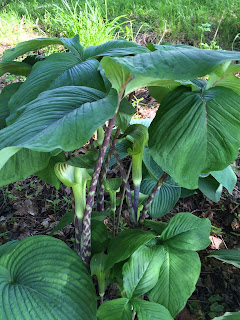 The gentle rain continues to fall while weighing down the large climbing rose shrub and the irises in our backyard garden. If allowed to grew, the rose would certainly climb up and cover a good portion of the roof of the neighbor's garage.
The gentle rain continues to fall while weighing down the large climbing rose shrub and the irises in our backyard garden. If allowed to grew, the rose would certainly climb up and cover a good portion of the roof of the neighbor's garage. The rain washed away today's intentions to plant in the Prospect Gardens. Early this morning I picked up the plants provided through the "Plant Dane. Cost Sharing Program." These lush plants are now waiting in our garage. Some will be inducted into the gardens, maybe tomorrow but no later than Monday. Others will be planted in the prairie garden at the intersection of the path and Glenway. In the trays are Black-eyed Susan, June Grass, Little Bluestem, Prairie Blazing Star, Rough Blazing Star, Side Oats Grama, and Prairie Drop Seed.
The rain did not prevent sharing cannas tubers from my backyard garden. Every year I plant cannas in pots and a few in the lower garden in anticipation that the hummer bird will once again come visiting. Love it when he comes buzzing in and lands on the red blooms while I am enjoying a cup of tea or reading a book.
And of course these prolific plants always generate many tubers to share with others. I almost had a full bushel basket of tubers; dug up last fall and stored in our basement. After planting what I wanted, the surplus was posted on several three neighborhood list servers. I was quite surprised that eight folks responded. The last six may be delivered this afternoon to a gardener who lives on Monroe Street and a few blocks from our house. She has several different species of prairie plants that she wants to give away and these will fit in nicely in the Prospect Gardens. So if the rain stops or let's up, I am off to meet another gardener and share the abundance that results from gardening.































